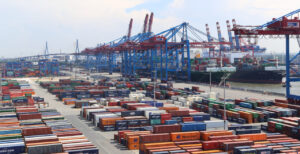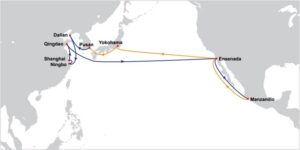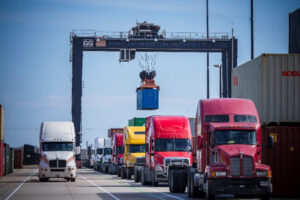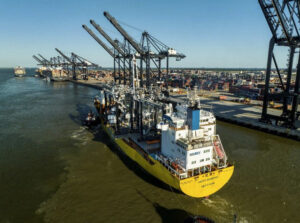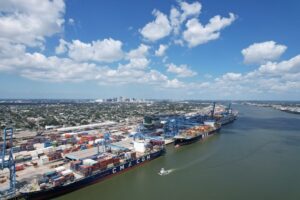Rakin Rahman, Staff Reporter at Port Technology International – PTI, sat down for an interview with Trine Nielsen, Head of Ocean EMEA at Flexport. The discussion focused on the current Red Sea crisis and its multifaceted impact on global trade, particularly shipping. The conversation touched on how coinciding events such as the Chinese New Year and the Suez Canal restrictions have further compounded the stifling impact the Red Sea crisis is having on global trade. Nielson stressed how the disruptions to trade could see increased levels of emissions emitted, shipping rates, and inflation, alongside delays in shipments.
How has the Red Sea crisis affected global shipping, considering the compounded effects of the restrictions in the Suez Canal, along with the Chinese New Year?
TN: Since 19 November, there have been dozens of attacks on commercial ships, including container ships, routing via the Suez. At this point, about 90 per cent of containerships that would’ve transited the Red Sea have diverted around Africa. The safety of the crew operating these ships is the top priority of everyone in the shipping industry. Ocean carriers are not making these decisions lightly.
As of the third week of January, about 560 carrier vessels accounting for nearly 7.6 million TEU of capacity (almost 25 per cent of global capacity) are actively diverting, will divert, or have diverted. Currently, all European-bound trade lanes remain impacted due to the situation in the Red Sea.
On the Transpacific Westbound and Far East Westbound, we continue to see delays and the situation in the Red Sea has fundamentally changed the supply-demand equation for at least the first quarter of 2024. Further, Flexport’s carrier partners have made it clear they’re committed to going around the Cape of Good Hope and are no longer waiting to see if this situation is going to be quickly mitigated. It’s clear carriers are reacting to what is viewed as a long-term situation.
The protracted situation in the Red Sea is occurring at an interesting time as the Lunar New Year begins on 10 Feb 2024 and is a milestone in the annual freight cycle. Typically, there’s a peak in the market as shippers try to move their goods before manufacturing in China shuts down for the holiday. Carriers will proactively position containers to capture the post-holiday ramp-up.
This year, however, we could see equipment shortages and containers out of position due to vessels rerouting around the Cape of Good Hope. The extended transit times of 8-21 days have displaced containers that should be in China to meet the post-holiday demand but won’t be. We’re already seeing equipment issues with TEU containers and high cubes, and shippers should be prepared to pay a premium for containers if they want their goods quickly after the holiday.
Looking past the Lunar New Year, we expect rates to go back to normal. The market hasn’t changed that much: there’s still more supply than demand. Carriers were already cutting back on capacity to match demand, and while it’s tough to predict consumer demand and overall trade right now, we don’t see a big increase in demand for 2024, based on what we’re hearing from customers and other demand indicators.
What would these impacts mean for shipping rates, inflation, and insurance premiums?
TN: Ocean freight prices are spiking even on trade lanes that on the surface would not be affected by the diversions like Asia to US West Coast lanes. With current estimates that re-routing via the Cape of Good Hope will prolong transit times by 7-10 days and as much as 2-3 weeks depending on a vessel’s location, more vessels will be required for expedited delivery, so carriers have had to pull capacity off those lanes onto the Asia to Europe trade. Sharing specific rates below:
- Asia to the US West Coast: standard service rates increased from just shy of $2,000 per forty-foot equivalent unit (FEU) around 15 December to more than north of $3,000 per FEU for the first half of January and more than $5,000 per FEU in the second half of January.
- Asia to the US East Coast: similar increases in magnitude as the US West Coast, rates have increased from about $2,800 per FEU around 15 December to more than $4,500 per FEU for the first half of January and above $7,000 per FEU in the second half of January.
- Asia to Europe: standard service rates increased from about $2,000 per FEU on 15 December to $4500 per FEU the second week of January and more than $6,000 per FEU in the second half of January.
- Premium rates will come at higher levels to guarantee equipment and loading. We’re hearing about some carriers announcing premium levels at more than $10,000 per FEU into the US West Coast by 15 January.
- Ocean freight prices are spiking even on trade lanes that on the surface would not seem to be affected by the diversions like Asia to US west coast lanes. The longer sailing time around the Cape of Good Hope requires more vessels so carriers have had to pull capacity off those lanes onto the Asia to Europe trade.
- Shippers have their hands tied if they need goods in the next three months – either accept high rates now or deal with equipment shortages post-Chinese New Year (CNY) which will also lead to elevated rate levels.
The average value of goods on each vessel transiting the Suez is around $1 billion. One factor that has helped bring down goods inflation has been the return of rapid delivery, though delays associated with avoidance of the Suez could lengthen journeys accordingly, thereby increasing pressures to hold inventory. Consumers have seen that prices have increased significantly due to shipping bottlenecks. This should settle down in the near term because of new fleets being delivered, about 10 per cent.
How much longer could we expect the crisis to persist, and what is the worst- and best-case scenario as it pertains to shipping?
TN: There is no resolution for the situation in the Red Sea on the horizon. We expect this to be a protracted situation that could last anywhere from several months to years. Currently, all European-bound trade lanes remain impacted due to the situation in the Red Sea. On the Transpacific Westbound and Far East Westbound, we continue to see delays and the situation in the Red Sea has fundamentally changed the supply-demand equation for at least the first quarter of 2024.
READ: Xeneta forecasts rise in ocean freight rates amid Red Sea crisis
Further, Flexport’s carrier partners have made it clear they’re committed to going around the Cape of Good Hope and are no longer waiting to see if this situation is going to be quickly mitigated. It’s clear carriers are reacting to what is viewed as a long-term situation. Rates today have increased by 3 times over the past month from Asia to North America and Europe. In general, we’re advising shippers who need goods in the next three months to anticipate higher rates. Due to shifts in capacity, we’re urging our customers to determine whether they’d rather take on higher rates now, or manage through the equipment shortages post-CNY which could also lead to elevated rates.
How will this impact shipping-related emissions, should ships have to travel longer voyages?
TN: Longer voyages naturally lead to increased fuel consumption. If carriers are trying to make up for lost time, they may increase speed which would lead to further fuel increases. If customers need faster delivery, they might switch to air freight, which can be 47 times more carbon-intensive than ocean freight. More burned fuel and mode shifts drive up both prices and greenhouse gas (GHG) emissions for customers.
Flexport’s emissions calculator automatically accounts for any changes in a ship or plane’s routing, ensuring accurate emissions estimates on all Flexport shipments. To mitigate the impact of increased emissions during this ongoing crisis, Flexport offsets all FLXT LCL shipment emissions on behalf of our clients, and makes available sustainable marine fuel insets for FCL shipments and sustainable aviation fuel insets for air freight, should customers want to use transportation-specific mitigation climate solutions
The introduction of the EU ETS, the new policy that has put a cap on carbon emissions, has coincided with all the current shipping woes that have forced ships into alternative routes. How could liners navigate this dilemma?
TN: Navigating the challenges requires a multi-faceted approach, focusing on both immediate adaptations and long-term strategic investments in sustainability.
READ: Shipping carriers adjust routes amid Red Sea crisis
As shippers have adjusted free time conditions to facilitate speedy equipment positioning back to Asia, we expect the ETS to be impacted by the higher fuel usage. To mitigate this, we recommend that shippers can significantly benefit from forming partnerships with other industry stakeholders, technology firms, and research bodies to fast-track the development and use of green technologies, share infrastructure for alternative fuels, and jointly invest in new solutions.
Additionally, integrating the cost of carbon into their financial and risk management plans, including budgeting for emissions allowances, and investing in future-proof technologies, is crucial for navigating the economic impacts of stricter emissions regulations.
READ: FMC calls public hearing on Red Sea shipping conditions
How can shipping companies fortify themselves and limit the damage incurred as much as possible?
TN: From an inventory perspective, we’re advising shippers who need goods in the next three months to anticipate higher rates. Due to shifts in capacity, we’re urging our customers to determine whether they would rather take on higher rates now, or manage through the equipment shortages post-CNY which could also lead to elevated rates.

Trine Nielsen is the Head of Ocean EMEA at Flexport where she applies her extensive experience in logistics, digital transformation, and customer engagement to drive Flexport’s expansion in the EMEA region. Prior to joining Flexport, Nielsen started her journey at Maersk where she initially led as Global Head of Twill Commercial and then as Global Head of Twill, driving substantial growth through her expertise in digital transformation and customer experience.


